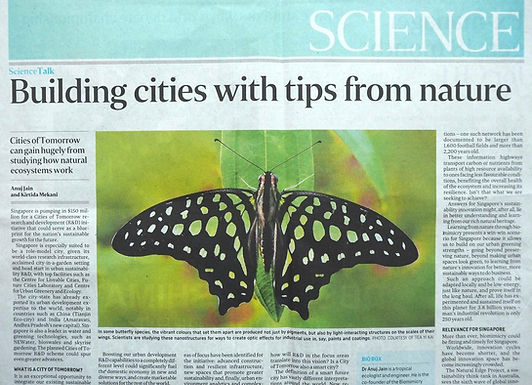Stories from Singapore
Here are a few stories from people in Singapore practicing biomimicry (sometimes unknowingly) that might interest you.
Biomimicry reaches government schools in Singapore
Jan 2020
Dr. Anuj Jain conducted two workshops for the Ministry of Education (MOE) Singapore teachers for them to bring biomimicry to the Science and Individual Research Study modules as part of the Gifted Education Program. The teachers had an opportunity to not only learn the basics of biomimicry but also practice nature journaling for biomimicry using a method developed by Biomimicry 3.8 called iSite. We also dived into several learning thrusts from materials and heat management to air and water flows and energy and magnets where we can draw lessons from nature. We are excited to see how the teachers bring this learning to students.


Teachers examining natural artifacts to understand their function and nature's design patterns
Urban Redevelopment Authority Singapore features Biomimicry Singapore Network and BBNL @ NTU
December 2019
A new article by the Urban Development Authority (URA) of Singapore covered Biomimicry Singapore Network and the Biological and Biomimetic Materials Laboratory (BBML) at the Nanyang Technological University (NTU) Singapore.
The author quoted Dr. Anuj as saying - “Circular economy, at its very root, is biomimicry. It’s a concept we learned from nature—nature produces no waste”. It also quoted Prof Ali Miserez from NTU whose lab is studying the structural, biochemical and physicochemical principles of natural organisms.


Denmark’s Kalundborg Eco-Industrial Park is the world’s first example of industrial symbiosis and adopts a circular approach to production ensuring an industry's waste becomes another's resource.
A new documentary on Nature's Tiny Superheroes on Channel News Asia
July 2019
Voiced by naturalist Nick Baker, Our Tiny Superheroes is an incredible introduction to the mini-marvels living among us, and the maverick scientists in Singapore who are trying to unlock the secrets of their superpowers. Do not miss watching this 42 mins documentary to understand the deep biomimicry research that is ongoing in Singapore.

UWC students working on a walking assistant inspired by the kangaroo

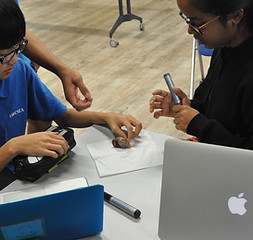
Studying snails to better wash away marks
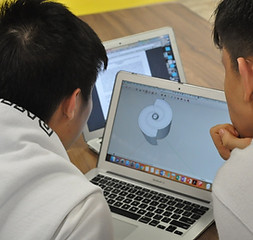

Mehul Gupta, Grade 11 Student at UWCSEA Dover, says – "the Biomimicry Design Challenge has been fantastic so far.
(TOP) Team 1 is designing a walking assistant which will allow people with difficulties in movement to move with ease. They are basing their design by mimicking a kangaroo and should have a model along with their idea ready by the end of the competition.
Team 2 (TOP LEFT) is attempting to mimic snails: the ability to wash away any marks off of their shells. They are currently investigating compounds such as calcium carbonate as possible chemicals to coat materials with and are doing associated experiments.
Team 3 (BOTTOM LEFT) is mimicking and combining many different elements of nature such as the spiral movement of kelp in water, whale flipper bumps and the spirals of conic shells to design a much more efficient fan. "
Nathan Hunt, Director of Sustainability at UWCSEA, says – "Almost all is student-led and self-organizing. I think the learning has been more important than the product so far. "
Studying movements of kelp, whales and shells to design an efficient fan
This semester-long challenge culminates in an exhibition at the school which will be judged by Mrs Kirtida Mekani (Co-founder, Biomimicry Singapore Network). The students stand the chance to win substantial funding to develop any promising prototypes.
UWCSEA Biomimicry Design Challenge - first of it's kind in Singapore
June 2018
The United World College in Singapore (UWC SEA) is running a semester-long student-led biomimicry design challenge with the help of UWC's IDEAS Hub where the students apply the principles of biomimicry to solving problems.
After a brief introduction to biomimicry, the students work with freely available resources on the internet such as Ask Nature site to learn the possibilities out there. They ideate solutions to a problem that may be around the school, in Singapore or globally.
The problem could be something we witness every day such as-
How do we stop air-conditioning being wasted by being too cold? How can we drink a juice carton without a plastic straw?
How can we store rain but not breed mosquitoes?
Use the SDGs as a guide.
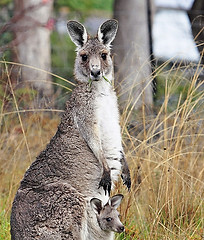
Photo by: young.rzd.ru
Flip Nicklin/Plainpicture
Biobrainstorm on packaging
30 Oct 2017
Dr. Anuj Jain taught a 1.5 days Biomimicry course on 30 - 31st Oct at the Singapore Botanic Gardens titled Designing with nature in the built environment (read more here). One of the highlights of the course was a 1.5 hour Biology to Design brainstorm exercise. The students were divided into 4 teams each of three participants. Using specially designed card decks which provided hints about natural organism and context, the participants came up with out-of-the-box ideas for sustainable packaging. I thought they had whacky names too such as the 'Living wrap', 'Radio ants' and 'Waste worm'.

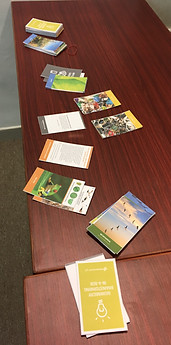


An example of design principles extracted from the natural organisms - the dock bug in this case. Resource by Biomimicry 3.8
A group photo of the course participants
Building cities with tips from nature
11 Aug 2017
Dr. Anuj Jain and Mrs. Kirtida Mekani wrote in STRAITS TIMES today about how answers to Singapore's sustainability innovation might, after all, lie in better understanding and learning from our rich natural heritage. Singapore has already championed tropical urban greenery and is one of the world’s most biodiverse cities. Can we also be champions in innovation from nature in the tropics, and spur a new generation of nature-inspired entrepreneurship? We will need to inculcate a practice of viewing nature as our classroom - a model, a measure and a mentor.
Read the online article here
Spur innovation by looking to nature for inspiration
Mr. Sivanatham Neelakandan writes in TODAY newspaper (December 23rd, 2016 issue) about how biomimicry could be a way to promote innovation in Singapore, particularly by adding biomimicry to the curriculum in primary and secondary schools. Applications of biomimicry are evident across disciplines such as engineering, energy, architecture, and transportation but few people know that the concepts have been applied to design better financial models, more resilient businesses, and more effective communications. We are thankful that Siva has kicked off discussions about biomimicry and innovation. Biomimicry Singapore is preparing a full-blown article on this issue. Stay tuned!
Read the online article here
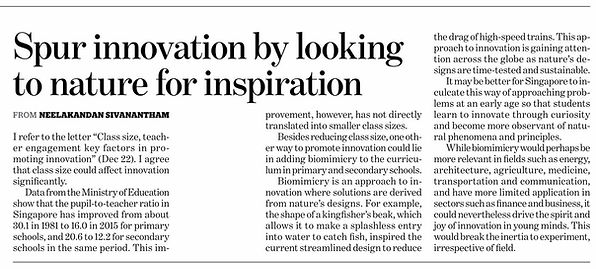
Understanding Biological Desalination in Mangroves and Biomimetic applications
The Singapore University of Technology and Design (SUTD) and NEWRI (Nanyang Environment & Water Research Institute, Nanyang Technology University) are collaborating on a major multi-disciplinary research grant to work on the understanding of various biological desalination mechanism(s) in the roots of mangroves. The next stage of the project is the biomimetic design and testing of various artificial mangrove-inspired structures for the purpose of desalinating seawater.
Principal Investigator: Associate Professor Jean W. H. Yong, Green Solutions Lab @ SUTD, Singapore. Contact: jyong@sutd.edu.sg
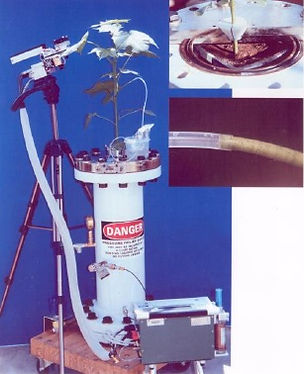

Insect inspired bioplastic
Dr. Fernandez, formerly from MIT and Harvard, has produced a new bioplastic isolated from shrimp shells. It’s made from chitosan, a form of chitin — the second-most abundant organic material on Earth. The manufacturing process is scaleable and introduces a 100% biodegradable alternative to synthetic plastic.
Though this example as-is is bio-utilization but it is included because it has the potential to become a biomimetic solution if the researchers can figure out how to manufacture 'chitin' sustainably.
Principal Investigator: Assistant Professor Javier Fernandez, The Fermart Lab @ SUTD, Singapore
http://people.sutd.edu.sg/~javier_fernandez/
Read more: Insect inspired bioplastic or Promising solution to plastic


Biomimicry incubators: business case for conservation
November 2014
By Sylvian Richer de Forges (Siloso beach resort, Director of Sustainability, Singapore)
The similarities between the natural and business world suggest that nature-inspired business models should be adopted instead of current frameworks which are clearly unfit for current and future challenges ahead such as tackling climate change.
Sylvian floated the ideas of "universities as incubators". Universities provide a unique setting to facilitate biomimicry. Led by the faculty of biology, identified traits of interest within species could easily be passed on to other faculties such as engineering, medical sciences, chemistry, social sciences and others as needed in order to mimic and adapt the traits for commercial industrial applications.
Communication issues and mind-set changes are challenges that need to be addressed.

An extract from Otto Lilienthal’s Mechanics of White Stork flight
‘Super Trees’ - Gardens by the Bay, Singapore
Gardens by the Bay is composed of 18 colossal, solar powered “supertree” structures that harbor several plants as well as two energy efficient biomes. The supertrees - designed to behave like natural trees - use a system of collection and absorption for water distribution, eliminating the need to water regularly. The trees use a system for dispersing heat trapped at the top of the structure to various temperature controlled areas.
On top of these branches, photovoltaic solar cells collect massive amounts of energy, which allows it to sustain the rest of the supertree systems. The branches are spread out allowing for maximum surface area for the solar panels. Various tropical flowers and plant life are embedded into the actual structure as well which maximizes the amount of foliage as well as giving the supertrees a more natural, living look.
The overall idea is of combining a natural concept with a futuristic look, an educational angle and to make this a tourist spectacle. Read more

Photo: Craig Sheppard
Yellow-fin tuna mimicking underwater vehicle
The promise of faster, energy efficient, agile and stealth vehicles for sea locomotion remains very appealing to the global economy. Underwater submersibles based on traditional propeller propulsion systems still have low efficiencies and open issues in balancing onboard energy and maneuverability at low speeds. In comparison, fish can change directions with a turning radius of 10-30% of their body length while maintaining their speeds.
In this research, Abhra Roy Chowdhury and colleagues from the Department of Electrical and Computer Engineering at the National University of Singapore looked at different species of fish for an efficient and agile locomotion solution to solve the current energy and maneuverability challenge for submersibles (or other vehicles for oceanic applications). After studying several species of fish and consulting with colleagues from the biology department, the answer came in the form of the swimming style (called the Body Caudal Fin (BCF) mode of swimming) of carangiform fish such as the tropical Yellow-fin tuna.
By mimicking the propulsion mechanism of carangiform fish, the underwater vehicle was found to be the 14.68% more efficient compared to a traditional undulatory propulsion. This is a state-of-the-art efficiency improvement. Being eco-friendly it terms of material use, energy efficiency, noise, and stealth, the device can easily find a place in a wide variety of ocean transport applications.
Part of this project was also submitted as part of Biomimicry Student Design Challenge 2014 by Abhra Roy Chowdhury and Anuj Jain. Download presentation here.


Photo extreme left: Underwater-vehicle mimicking Yellow-fin tuna swimming style
Photo left: Right undulation of underwater vehicle and its velocity field optimized for low drag
Citation: Abhra Roy Chowdhury and S.K. Panda., Finding Answers to Biological Control Methods using Modulated Patterns: An Application to Bio-inspired Robotic Fish, IEEE International Conference on Robotics and Automation (ICRA), Seattle, USA, May 2015, pp. 3146 - 3153.


